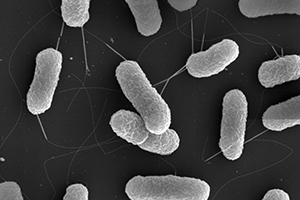Sweetening the activator
Lassak et al. 2015, Nature Chemical Biology (with Prof. K. Jung, Microbiology Department)
19.02.2015
Arginine-rhamnosylation as new strategy to activate translation elongation factor P
Jürgen Lassak, Eva Keilhauer, Maximilian Fürst, Kristin Wuichet, Julia Gödeke, Agata L Starosta, Jhong-Min Chen, Lotte Sřgaard-Andersen, Jürgen Rohr, Daniel N. Wilson, Susanne Häussler, Matthias Mann & Kirsten Jung
Nature Chemical Biology 2015, DOI: 10.1038/nchembio.1751
Abstract:
Ribosome stalling at polyproline stretches is common and fundamental. In bacteria, translation elongation factor P (EF-P) rescues such stalled ribosomes, but only when it is post-translationally activated. In Escherichia coli, activation of EF-P is achieved by (R)-β-lysinylation and hydroxylation of a conserved lysine. Here we have unveiled a markedly different modification strategy in which a conserved arginine of EF-P is rhamnosylated by a glycosyltransferase (EarP) using dTDP-L-rhamnose as a substrate. This is to our knowledge the first report of N-linked protein glycosylation on arginine in bacteria and the first example in which a glycosylated side chain of a translation elongation factor is essential for function. Arginine-rhamnosylation of EF-P also occurs in clinically relevant bacteria such as Pseudomonas aeruginosa. We demonstrate that the modification is needed to develop pathogenicity, making EarP and dTDP-L-rhamnose–biosynthesizing enzymes ideal targets for antibiotic development. (cited from Nature Chemical Biology)
(see also LMU News, Feb 17,2015)
Contact:
Prof. Dr. Kirsten Jung / Prof. Dr. Jürgen Lassak
Department Biology I, Microbiology
Telefon: +49 (0)89 / 2180-74500/ -74508
E-Mail: jung@lmu.de; juergen.lassak@lmu.de
http://www.mikrobiologie.biologie.uni-muenchen.de


